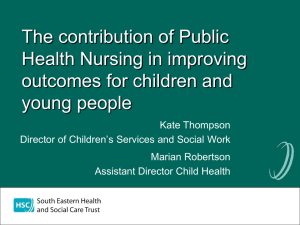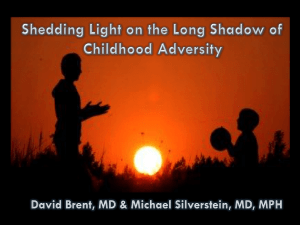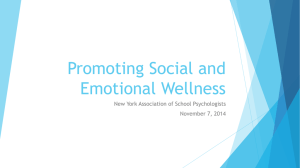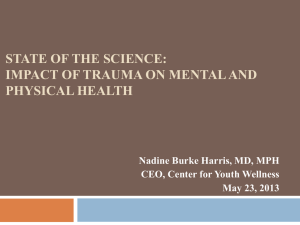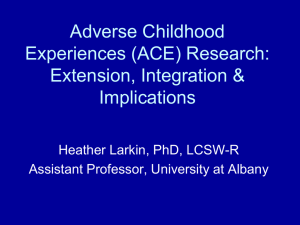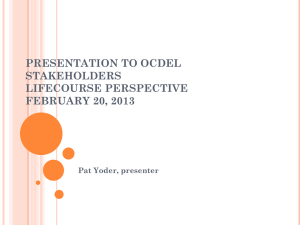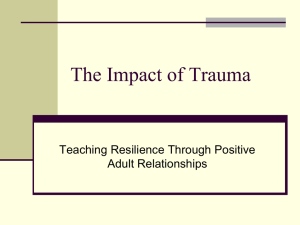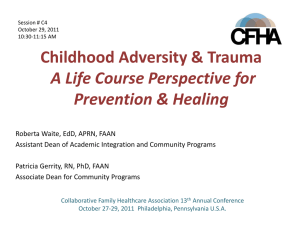Review_of_ACE_Study_.. - Adverse Childhood Experiences Study
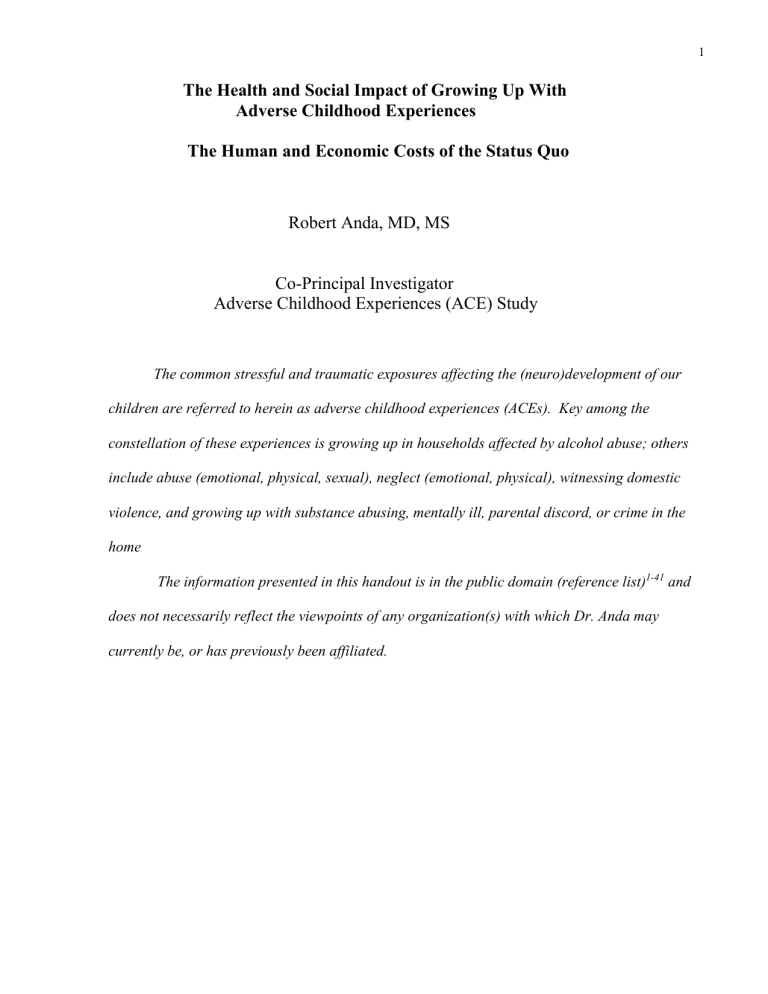
The Health and Social Impact of Growing Up With
Adverse Childhood Experiences
The Human and Economic Costs of the Status Quo
Robert Anda, MD, MS
Co-Principal Investigator
Adverse Childhood Experiences (ACE) Study
The common stressful and traumatic exposures affecting the (neuro)development of our children are referred to herein as adverse childhood experiences (ACEs). Key among the constellation of these experiences is growing up in households affected by alcohol abuse; others include abuse (emotional, physical, sexual), neglect (emotional, physical), witnessing domestic violence, and growing up with substance abusing, mentally ill, parental discord, or crime in the home
The information presented in this handout is in the public domain (reference list)
1-41
and does not necessarily reflect the viewpoints of any organization(s) with which Dr. Anda may currently be, or has previously been affiliated.
1
Executive Summary
2
The Adverse Childhood Experiences (ACE) Study is a decade-long and ongoing study designed to examine the childhood origins of many of our Nation’s leading health and social problems. The
Study represents collaboration between the Nation’s leading prevention agency, the Centers for
Disease Control and Prevention (CDC) and the Kaiser Health Plan’s Department of Preventive
Medicine in San Diego, CA.
1-41
The key concept underlying the Study is that stressful or traumatic childhood experiences such as abuse, neglect, witnessing domestic violence, or growing up with alcohol or other substance abuse, mental illness, parental discord, or crime in the home (which we termed adverse childhood experiences—or ACEs) are a common pathway to social, emotional, and cognitive impairments that lead to increased risk of unhealthy behaviors, risk of violence or re-victimization, disease, disability and premature mortality (Figure A).
1-4,36,37
We now know from breakthroughs in neurobiology that ACEs disrupt neurodevelopment and can have lasting effects on brain structure and function—the biologic pathways that likely explain the strength of the findings from the ACE
Study.
1
Figure A.-Conceptual Framework for the ACE Study
Death
Early
Death
Disease, Disability and Social Problems
Adoption of
Health-risk Behaviors
Social, Emotional, &
Cognitive Impairment
Adverse Childhood Experiences
Scientific gaps
Conception
We found that ACEs are common , even in a relatively well educated population of patients enrolled in one of the Nation’s leading HMOs.
1,13,18,2336,37
More than 1 in 4 grew up with substance abuse and two-thirds had at least one ACE! More than 1 in 10 had 5 or more ACEs!
And we found that ACEs are highly interrelated .
13
In order to assess the relationship of the
ACEs to health and social problems we developed the ACE Score,
36.37
which is a count of the number of ACEs designed to assess their cumulative impact on childhood development and therefore, their impact on a variety of health and social priorities in our country.
What we found, using the ACE Score, stunned us even more. As the ACE Score increases so does the risk of numerous health and social problems throughout the lifespan (See Figure below).
These problems are a “Who’s Who?” list of problems that encompass the priorities of many agencies, public and private, that are working to prevent and treat a vast array of problems.
1-41
A summary of the problems strongly associated with the ACE Score follows.
Adverse Childhood Experiences
As a National Health Issue
ACEs have a strong influence on:
-adolescent health
-teen pregnancy
-smoking
-alcohol abuse
-illicit drug abuse
-sexual behavior
mental health
risk of revictimization
stability of relationships
performance in the workforce
And…
ACEs increase the risk of:
Heart disease
Chronic Lung disease
Liver disease
Suicide
- Injuries
HIV and STDs
and other risks for the leading causes of death
This vast array of problems that arise from ACEs calls for an integrated, rather than a separate or categorical perspective of the origins of health and social problems throughout the lifespan.
This approach to growing up with ACEs, and to the consequences of exposure to them, may unify and improve our understanding of many seemingly unrelated health and social problems that tend to be identified and treated as categorically separate issues in Western society. Development of more integrated approaches will likely contribute to more meaningful diagnoses, improved treatment of affected persons, and better integration of research priorities, preventive and social services, and legal venues.
1,3
The ACE Study calls for an integrated approach to intervene early on children growing up being abused, neglected, witnessing domestic violence, or with substance abusing, mentally ill, or criminal household members. All of these childhood stressors are interrelated and usually cooccur in these homes. Prevention and treatment of one ACE frequently can mean that similar efforts are needed to treat multiple persons in affected families.
3
Introduction
This overview focuses on key findings from the ACE Study, published in peer-reviewed
4 scientific journals, with an emphasis on how growing up with alcohol abuse and/or illicit drug use in the home becomes part of a spectrum of damaging childhood experiences. These childhood traumas lead to a wide array of negative health and social consequences.
The key concept behind the design of the ACE Study is that risk factors for health and social problems are not randomly distributed in the US population. We hypothesized that the experiences of childhood—specifically stressful or traumatic experiences that can negatively affect childhood development were fundamental underpinnings of the occurrence of these problems. We sought to fill the “scientific gaps” using a whole life model as depicted in Figure 1, below.
36,38
Figure 1-Conceptual Framework for the ACE Study.
Death
Early
Death
Disease, Disability and Social Problems
Adoption of
Health-risk Behaviors
Social, Emotional, &
Cognitive Impairment
Adverse Childhood Experiences
Scientific gaps
Conception
It is important to recognize that:
Adverse childhood experiences (ACEs) are common.
ACEs tend to occur in clusters, rather than single experiences.
The cumulative impact of multiple exposures can be captured in an “ACE Score”.
The ACE score likely captures the cumulative (neuro)developmental consequences of traumatic stress.
The ACE Score has a strong, graded relationship to numerous health, social, and behavioral problems throughout a person's lifespan
These ACE-related problems tend to be co-morbid or co-occurring
These points will be highlighted in the course of this review.
5
Design of the ACE Study
The Adverse Childhood Experiences (ACE) Study is the largest of its kind ever conducted both in size and scope of information collected. It examines the health and social effects of adverse childhood experiences throughout the lifespan and is an ongoing, decade-long collaboration between the Division of Adult and Community Health at the Centers for Disease Control and
Prevention (CDC) and Kaiser Permanente’s Department of Preventive Medicine in San Diego.
The relationship of these experiences to a wide range of health and social problems throughout the lifespan has been, and continues to be, described by the ACE Study team.
1,36,38
During two survey “waves” conducted during 1995 to 1997, 17,337 predominantly well educated, middle-class members of the Kaiser Permanente Medical Care Program in San Diego,
California agreed to participate in the Study, as part of a comprehensive medical evaluation.
38
Prospective assessment of the relationships of ACEs to health care utilization, rates of pharmaceuticals prescribed, disease incidence, and causes of death is an ongoing focus of the
Study (Figure 2).
Figure 2.—Design of the ACE Study
ACE Study Design
Survey Wave I--70% response Mortality
(9,508/13,494) National Death Index
Follow-up
Morbidity
Hospital Discharge
Outpatient Visits
( N = 17,421)
Survey Wave II--65% response Emergency room
(8,667/13,330) visits
Pharmacy Utilization
All medical evaluations abstracted from both waves
The ACE study population included 9,367 (54%) women and 7,970 (46%) men (total sample=17,337). Their mean age was 56 years. Seventy-five percent were white, 39% were college graduates, 36% had some college education, and 18% were high school graduates. Only
7% had not graduated from high school.
1,13
The Study assessed 10 categories of stressful or traumatic childhood experiences.
13
The experiences chosen for study were based upon prior research that has shown them to have significant adverse health or social implications, and for which efforts in the public and private sector exist to reduce the frequency and consequences of their occurrence.
Prior research into the effects of childhood maltreatment and related experiences (including witnessing domestic violence) has tended to focus on only one or two categories of experience, such as physical or sexual abuse or domestic violence, and has generally focused on a limited range of outcomes. The ACE Study is unique not only because of its size, but because it was also designed to assess the relationships of a broad range of adverse childhood experiences (ACEs) to a wide range of health and social consequences.
The 10 ACEs studied are as follows:
Childhood abuse
-Emotional
-Physical
-Sexual
Neglect
-Emotional
-Physical
Growing up in a seriously dysfunctional household as evidenced by:
-Witnessing domestic violence
-Alcohol or other substance abuse in the home
- Mentally ill or suicidal household members
- Parental marital discord (as evidenced by separation or divorce)
- Crime in the home (as evidenced by having a household member
imprisoned)
ACEs Are Common
6
The first important conclusion to be drawn is that adverse childhood experiences are very common, even in this well-educated, predominantly middle-class study sample (Figure 3, below).
1,13,36,38 Moreover, ACE Study estimates of the prevalence of childhood exposures to physical and sexual abuse are similar to population-based surveys. A national telephone survey of adults conducted by Finkelhor et al.
43
used similar criteria for childhood sexual abuse and determined that 16% of men and 27% of women had been sexually abused; in the ACE Study cohort 16% of men and 25% of women in our sample had experienced contact childhood sexual abuse. In our study, 30% of the men had been physically abused as boys; this closely parallels the
31% prevalence recently found in a similarly structured population-based study of Canadian men
44
The similarity of the estimates from the ACE Study to those of population-based studies suggests that our findings would be applicable in other settings.
Figure 3. – Prevalence of Adverse Childhood Experiences 1,13
Adverse Childhood Experiences Are Common
Household dysfunction:
Substance abuse 27%
Parental sep/divorce 23%
Mental illness 17%
Battered mother 13%
Criminal behavior 6%
Abuse:
Psychological 11%
Physical
Sexual
28%
21%
Neglect:
Emotional 15%
Physical 10%
ACEs are Highly Interrelated
Probably as a result of the categorical approaches to the various ACEs, at the time that the ACE
Study was designed relatively little was known about the co-occurrence of the 10 ACE categories chosen for study. Even less was known about the cumulative impact of multiple different exposures. Because initial analyses of the data showed that ACEs tended to be highly interrelated, 13,36,38 we described their co-occurrence in detail.
13 Figures 4 and 5 illustrate how growing up with alcohol abusing parents is strongly related to the risk of experiencing other categories of ACEs.
13
Figure 4.-Alcohol Abuse and the Risk of Childhood Abuse
7
25
20
15
10
5
0
50
Alcohol Abuse in the Home and the Risk of Childhood Abuse
Number of alcohol abusers:
45
0 1 2 or more
40
35
30
Emotional Physical
Type of Abuse
Sexual
Figure 5.-Alcohol Abuse in the Home and the Risk of Other ACEs
35
30
25
20
15
10
Alcohol Abuse in the Home and the Risk of Other Household Exposures During Childhood
45
40
Number of alcohol abusers:
0 1 2 or more
5
0
Mother treated violently
Mental illness
Drug use
Suicide attempt
Member imprisoned
8
The Occurrence of One ACE Should Evoke a Search for Others
Table 1 shows the probability (%) of experiencing additional ACEs based upon the occurrence of each individual category of ACE.
5 In the case of persons who had grown up with household substance abuse, 81% reported at least one additional ACE and the majority had experienced 2 or more ACES. In the entire study population, 81%-98% of respondents who had experienced one
ACE reported at least one additional category of ACE (median: 87%).
13
Table 1.-Prevalence of Each Category of Adverse Childhood Experience and Likelihood of Other
ACEs
13
Additional ACEs (%)
ACE category
0 ≥ 1 ≥ 2 ≥ 3 ≥ 4 ≥ 5 ≥ 6
Abuse
Emotional
Physical
Sexual
2
17
22
98
83
78
90
64
58
77
46
42
62
32
29
42
20
19
25
12
12
Neglect
Emotional 7 93 79 63 47 32 19
Physical 11 89 75 61 50 37 24
Household dysfunction
Parental separation or divorce
Household substance abuse
Household mental illness
Battered Mother
Crime
Median
18
19
16
5
10
13.5
82 61 43 30
81 60 41 29
84 65 48 34
95 82 64 48
90 74 56 43
86.5 69.5 52.0 38.5
78-98 58-90 41-77 29-62
19
18
21
32
30
25.0
12
11
13
20
23
16.0
Range 2-22 18-42 11-25
Thus, ACEs are highly interrelated; the occurrence of one should evoke a search for others.
In addition, this interrelatedness made assessment of the effects of single ACEs on health and social well-being illogical.
The ACE Score
Because adverse childhood experiences are highly interrelated, we developed the ACE Score as a measure of the cumulative exposure to abuse, neglect, alcohol and other substance abuse, domestic violence and other forms of serious household dysfunction.
1,13,36,38 Exposure to any ACE category (Table 1, above) counted as one “point” on the Score; the number of categories of adverse experience were then summed. The ACE Score therefore ranged from 0 to 10. The ACE Score indicates, in summary form, the amount of exposure to the ten categories of adverse experience in childhood and adolescence. There was no further scoring within a category. Statistical analysis has confirmed that the observed number of respondents with high ACE scores was notably higher than the expected number under the assumption of independence of ACEs (p<.0001).
13
The prevalence of the ACE Scores by gender is presented in Table 4.
13
Two-thirds of participants reported at least one category of ACE. One in ten people had an ACE Score of 5 or more; higher ACE Scores are
somewhat more common in women. Even in this well educated population of HMO patients, less
9 than one-third had an ACE Score of 0! Or from the perspective of a provider of health or social services in this population 1 or 2 out of every ten adults seen have an ACE Score of 5 or more!
Table 4. Prevalence of the ACE Score by Gender
Women
Prevalence (%)
Men Total
ACE Score
0
1
2
31.3
24.2
14.8
34.2
27.3
16.4
32.7
25.6
15.5
3
4
>5
10.4
6.8
12.5
9.3
4.8
8.0
9.9
5.9
10.5
The ACE Score Has a Graded Relationship to Numerous Health and Social Outcomes:
An Indicator of the Effects of Cumulative Stress on (Neuro)Development
The relationship of the ACE Score to a wide range of health, emotional, and social outcomes has been described.
1-41
It is noteworthy that the use of the ACE Score as a measure of the cumulative exposure to traumatic stress during childhood is consistent with more recent understanding, from the neurosciences
1,45 of the effects of traumatic stress on neurodevelopment.
Neuroscientists have linked childhood maltreatment--using experimental animal models as well as case-control studies in humans--to long-term changes in brain structure and function, involving several inter-connected brain regions including the prefrontal cortex, hippocampus, amygdala, corpus callosum, and cerebellum.
46-51 Early stress is also associated with lasting alterations in stress-responsive neurobiological systems, including the hypothalamic-pituitary-adrenal axis and monoamine neurotransmitter systems; these lasting effects on the developing brain would be expected to affect numerous human functions into adulthood including (but not limited to) emotional regulation, somatic signal processing (body sensations), substance abuse, sexuality, memory, arousal, and aggression.
52-57
Numerous publications have documented a graded or “dose-response” relationship between the number of categories of ACEs (ACE Score) and a wide variety of health and social problems of national importance.
1-41 I consider the “dose-response” findings quite literally; the ACE Score appears to capture cumulative exposure of the developing brain to the activated stress response, which is the pathway by which ACEs exert their neurobiological impact. This “dose response” relationship is evident in the figures that follow in the next section; as the ACE Score goes up, so does the risk of problems from adolescence to adulthood.
Relationship of the ACE Score to Alcohol Use and Abuse
One of the strongest relationships seen was between the ACE score and alcohol use and abuse
(Figure 5).
2,25
Given recent research indicating the negative impact of alcohol use on neurodevelopment of adolescents, the relationship of ACEs to early initiation of alcohol use is particularly worrisome. The negative health and social consequences of alcohol abuse and alcoholism constitute a major public health problem—and ACEs have a particularly strong association with alcohol abuse. In addition, it is notable that the perpetuation of the cycle of alcohol abuse appears to be tightly interwoven with the number of ACEs, including marriage to an alcoholic.
10
Figure 6.- Relationship of the ACE Score to Alcohol Use and Abuse
40
35
30
25
20
15
10
5
The ACE Score …
Alcohol Use and Abuse
ACE Score
0 1 2 3 4 or more
0
Early initiation of use
(by age14)
Problem with alcohol use
Alcoholic Married an
Alcoholic
The ACE Score and Risk Factors for HIV/AIDs
The risk factors for transmission of the Human Immunodeficiency Virus (HIV), the causative agent of the AIDS epidemic are now well known. What appears to be less well known is that ACEs are a major hidden “engine” underlying these preventable risk factors for the transmission of HIV
(Figure 6). Injected drug use, promiscuity (defined as having had 50 or more lifetime intercourse partners), and ever having a sexually transmitted disease (including AIDs), all increase dramatically as the ACE Score increases.
11,16,29,35,38
Figure 7.- The ACE Score and Risk Factors for HIV/AIDs
ACE Score and HIV Risks
20
18
16
14
12
10
4
2
0
8
6
ACE Score
0 1 2 3 4 or more
Ever Injected
Drugs
Had 50 or More
Intercourse Partners
Ever Had an
STD
The ACE Score, Smoking, and Chronic Obstructive Pulmonary Disease
Cigarette smoking is the leading cause of preventable morbidity and mortality in the United
States. Unfortunately, as with initiation of alcohol use, ACEs increase the likelihood of early smoking initiation.
36 Moreover, ACEs lead to continued smoking and the risk of Chronic
Obstructive Pulmonary Disease (COPD; one of the 10 leading causes of death in the US).
36,38
Figure 8.--Relationship of the ACE Score to Smoking and COPD
11
The ACE Score, Smoking, and Lung Disease
12
10
8
6
4
2
0
20
18
16
14
ACE Score
0 1 2 3 4 or more
Early smoking initiation
Current smoking COPD
ACEs, Depression, and Suicide Attempts (Figure 8)
Depression is now recognized to be a leading cause of disability worldwide, and ACEs bear a strong relationship to this common mental health problem; the relationship is equally strong for both men and women.
15
Suicide is a leading cause of death in the US with a “bimodal” age pattern of attempts—one peak in adolescence and one in middle age. Here also, ACEs have a powerful graded relationship to the risk of suicide attempts; this holds for attempts by men and women and attempts during adolescence or adulthood.
34
12
Figure 9, - Relationship of the ACE Score to Depression and Suicide Attempts
The ACE Score and a Lifetime History of
Depression or Suicide Attempts
60
50
Depression Suicide
40
30
20
10
0
0 1 2
ACE Score
3 >=4
By now it should be obvious that the long term human costs of ACEs are enormous and that the problems associated with these problems also translate into costs of health care, disability, and social services. Now, let’s turn to two examples where the costs—in economic terms—are most obvious.
ACEs Affect Worker Performance
Inasmuch as ACEs affect the health and well-being of the workforce, they are a hidden drain on profitability for corporate America. The human and economic costs of the long-term effects of adverse childhood experiences on the workforce are likely major and merit attention by the business community in concert with the modern practice of medicine and public health. Recent studies estimated annual costs as high as $28 billion for chronic back pain for US businesses, 58 $30-
$44 billion for depression and related absenteeism, reduced productivity, and medical expenses,
59 and $246 billion for chemical dependency in the workforce.
60
These massive losses occur despite safety programs and the most expensive medical care system in the world.
61 If these areas are indeed related to the performance of the workforce, profitability of businesses and even national productivity are likely to be affected as well.
Absenteeism, financial problems, and self-reported problems on the job are all indicators of impaired productivity that are expensive and are also indicators of ACE related problems such as alcohol abuse, chronic pain, mental health disorders, and others. Figure 9 displays the relationship of ACEs to these indicators of reduced worker productivity.
10
Figure 10.-ACEs and Indicators of Impaired Worker Performance
ACE Score and Indicators of
Impaired Worker Performance
25
20
ACE Score
0 1 2 3 4 or more
15
10
5
0
Absenteeism
(>2 days/month)
Serious
Financial
Problems
Serious
Job
Problems
ACEs and Direct Health Care Costs—Prescription Pharmaceuticals
Nearly $180 billion were spent on prescription drugs in the United States in 2003. This represents approximately 11% of total national health expenditures and was more than four times the amount spent in 1990.
62
One of the most rapidly rising set of prescribed drugs is antidepressants; how do ACEs affect their use?
Figure 11.-The ACE Score and Rates of Antidepressant Prescriptions 4
13
ACE Score and Rates of Antidepressant
Prescriptions
100
90
80
30
20
10
0
70
60
50
40
0 1 2 3 4 >=5
ACE Score
14
Given the results of the ACE Study, what are the human, social, and economic costs of the high prevalence, interrelatedness, and long-term consequences of Adverse Childhood
Experiences?
Implications
The effects of ACEs are long-term, powerful, cumulative, and likely to be invisible to health care providers, educators, social service organizations, and policy makers because the linkage between cause and effect is concealed by time, the inability to “see” the process of neurodevelopment, and because effects of the original traumatic insults may not become manifest until much later in life.
1,3,36,38
When a child is wounded, the pain and negative long-term effects reverberate as an echo of the lives of people they grew up with—and then they grow up, at risk for taking on the same characteristics and behaviors—thereby sustaining the cycle of abuse, neglect, violence and substance abuse, and mental illness. For example, ACEs greatly increase the risk of adult alcohol abuse or marriage to an alcoholic,
25 perpetuating the adversities and their consequences.
28
Thus, growing up with alcohol abuse contributes to many of the leading chronic health and social problems in the United States.
Information from the ACE Study suggests that traumatic stressors during childhood and adolescence represent a common pathway to a variety of important long-term behavioral, health, and social problems (see Appendix, page 22).
Thus, an integrated rather than a separate or categorical, perspective on the origins of health and social problems throughout the lifespan is needed. This approach to alcohol abuse and related ACEs, and to the consequences of exposure to them, may unify and improve our understanding of many seemingly unrelated health and social problems that tend to be identified and treated as categorically separate issues in Western culture.
The ACE Score appears to be a robust of the cumulative, lifetime impact of traumatic stress on neurodevelopment in childhood. Stressful and traumatic childhood and adolescent experiences literally become “biology” affecting brain structure and function (as well as endocrine, immune, and other biologic functions) thus leading to persistent effects. Until now, these persistent effects were “hidden” from the view of both neuroscientists and public health researchers. This is no longer the case . In fact, with this information comes the responsibility to use it. 40
These links between childhood experience and adult health and social function have significant implications for health and social services. We found that adults who reported any single category of adverse childhood experience were likely to have suffered multiple other categories during childhood. Therefore, assessment of exposure to other ACEs is important when working with children or adults identified as having had any single type of ACE. Children experiencing alcohol abuse in the home should be screened for other types of maltreatment and traumatic stressors—and vice versa! This information, if routinely gathered will likely contribute to more meaningful diagnoses, earlier and improved treatment of exposed children and their caretakers , and better integration of prevention, social services, and legal venues.
Facing the high prevalence and interrelatedness of ACEs is going to be tough. Categorical approaches to the individual ACEs as well as the health and social problems strongly related to them tend to be “siloed”. However, the professions, research priorities, organizations, and resources that are necessary to healing frequently exist in “silos”--separate, often competitive rather than collaborative, entities, each preserving and advancing the resources and work that is historically "theirs". While this is understandable, to succeed, we must make this "ours", a team effort that reaches beyond traditional boundaries and borders.
Prevention and remediation of our nation’s leading health and social problems are likely to benefit from integrated approaches that incorporate information about their common origins in the enduring neurodevelopmental consequences of growing up with alcohol abuse and related adverse experiences during childhood.
15
References
1. Anda RF, Felitti VJ, Walker J, Whitfield, CL, Bremner JD, Perry BD, Dube SR, Giles WH. The
Enduring Effects of Abuse and Related Adverse Experiences in Childhood: A Convergence of
Evidence from Neurobiology and Epidemiology. European Archives of Psychiatry and Clinical
Neurosciences, 2006; 256(3):174-86
2. Dube SR, Miller JW, Brown DW, Giles WH, Felitti VJ, Dong M, Anda RF. Adverse Childhood
Experiences and the Association with Ever Using Alcohol and Initiating Alcohol Use During
Adolescence. . Journal of Adolescent Health, 2006;38(4):444.e1-444.e10.
3. Anda, RF, Felitti, VJ, Brown, DW, Chapman, D, Dong, M, Dube, SR, Edwards, VJ,
Giles, WH. (2006) Insights Into Intimate Partner Violence From the Adverse Childhood
Experiences (ACE) Study. In PR Salber and E Taliaferro, eds. The Physician's Guide to
Intimate Partner Violence and Abuse, Volcano, CA: Volcano Press; 2006.
4. Congressional Briefing. Anda, RF and Felittii, VJ. Adverse Childhood Experiences as a
National Public Health Problem. Sponsored by the American Academy of Pediatrics and
The Family Violence Prevention Fund. Capitol Hill, Washington, DC. April 18, 2006.
5. Dong M, Anda RF, Felitti VJ, Williamson DF, Dube SR, Brown DW, Giles WH. Impact of
residential mobility during childhood on health in adults: The hidden role of Adverse Childhood
Experiences. Archives of Pediatrics and Adolescent Medicine. 2005;159:1104-1110.
6. Edwards VJ, Anda RF, Dube SR, Dong M, Chapman DF, Felitti VJ. The wide-ranging health
consequences of adverse childhood experiences. In: K Kendall-Tackett and S
Giacomoni, eds. Child Victimization: Maltreatment, Bullying, and Dating Violence Prevention
and Intervention, Kingston, NJ:Civic Research Institute;2005:8-1-8-12.
7. Dube SR, Anda RF, Whitfield, CL, Brown DW, Felitti VJ, Dong M, Giles WH. Long-Term
Consequences of Childhood Sexual Abuse by Gender of Victim. American Journal of
Preventive Medicine. 2005;28:430-438.
8. Whitfield CL, Dube SR, Felitti VJ, Anda RF. Adverse Childhood Experiences and Subsequent
Hallucinations. Child Abuse & Neglect. 2005; 29: 797-810
9. Hillis SD, Anda RF, Dube SR, Felitti VJ, Marchbanks PA, Marks JS. The association between
adolescent pregnancy, long-term psychosocial outcomes, and fetal death. Pediatrics. 2004;
113(2):320-327.
10. Anda RF, Felitti VJ, Fleisher VI, Edwards VJ, Whitfield CL, Dube SR, Williamson DF.
Childhood abuse, household dysfunction and indicators of impaired worker performance in
adulthood. The Permanente Journal. 2004; 8(1):30-38.
11. Dong M, Dube SR, Giles WH, Felitti VJ. Anda, RF. Adverse childhood experiences and self-
reported liver disease: new insights into the causal pathway. Archives of Internal Medicine.
2004;164(4):460; author reply 460-1
12. Dube SR, Williamson DF, Thompson T, Felitti VJ, Anda RF. Assessing the reliability
of retrospective reports of adverse childhood experiences among adult HMO members
attending a primary care clinic. Child Abuse and Neglect. 2004;28(7):729-737.
13. Dong M, Anda RF, Felitti, VJ, Dube SR, Williamson DF, Thompson TJ, Loo CM. Giles WH.
16
The interrelatedness of multiple forms of childhood abuse, neglect, and household
dysfunction. Child Abuse and Neglect. 2004;28(7):771-784.
14. Dong M, Giles WH, Felitti VJ, Dube, SR, Williams JE, Chapman DP, Anda RF. Insights into causal pathways for ischemic heart disease: the adverse childhood experiences study.
Circulation. 2004;110:1761-1766.
15. Chapman DP, Anda RF, Felitti VJ, Dube SR, Edwards VJ, Whitfield CL. Epidemiology
of adverse childhood experiences and depressive disorders in a large health maintenance
organization population. Journal of Affective Disorders. 2004;82:217-225.
16. Dube SR, Felitti VJ, Dong M, Chapman DP, Giles WH, Anda RF. Childhood Abuse, Neglect. and Household Dysfunction and the Risk of Illicit Drug Use: The Adverse Childhood
Experience Study. Pediatrics. 2003;111(3):564-572.
17. Whitfield CL, Anda RF, Dube SR, Felitti VJ. Violent childhood experiences and the risk of
intimate partner violence in adults: assessment in a large health maintenance organization.
Journal of Interpersonal Violence. 2003;18(2):166-185.
18. Dong M, Anda RF, Felitti VJ, Dube SR, Giles WH. The relationship of exposure to childhood
sexual abuse to other forms of abuse, Neglect. and household dysfunction during childhood.
Child Abuse and Neglect. 2003;27(6):625-639.
19. Dube SR, Felitti VJ, Dong M, Giles WH, Anda RF. The impact of adverse childhood
experiences on health problems: evidence from four birth cohorts dating back to 1900.
Preventive Medicine. 2003;37(3):268-77.
20. Edwards, V. J., Holden, G. W., Anda, R. F., & Felitti, V. J. Experiencing multiple forms of
childhood maltreatment and adult mental health: results from the adverse childhood
experiences (ACE) study. American Journal of Psychiatry. 2003;160(8):1453-60.
21. Dong M, Anda RF, Dube SR, Felitti VJ, Giles WH. Adverse childhood experiences and self-
reported liver disease: new insights into a causal pathway. Archives of Internal Medicine.
2003;163:1949-1956.
22. Edwards VJ, Anda RF, Felitti VJ, Dube SR. Adverse childhood experiences and health-related
quality of life as an adult. In: K Kendall-Tackett, ed. Health Consequences of Abuse in the
Family: A Clinical Guide for Evidence-Based Practice. Washington, DC:American
Psychological Association; 2003:81-94.
23. Dube SR, Anda RF, Felitti VJ, Edwards VJ, Williamson DF. Exposure to abuse, Neglect. and
household dysfunction among adults who witnessed intimate partner violence as children.
Violence and Victims. 2002;17(1): 3-17.
24. Felitti VJ. The relationship between adverse childhood experiences and adult health: Turning
gold into lead. The Permanente Journal. 2002;6:44-47. Also available in German.
25. Dube SR, Anda RF, Felitti VJ, Edwards VJ, Croft JB. Adverse childhood
experiences and personal alcohol abuse as an adult. Addictive Behaviors. 2002;27(5):713-725.
26. Williamson DF, Thompson, TJ, Anda, RF,. Dietz, WH, Felitti VJ. Body weight,
17
obesity, and self-reported abuse in childhood. International Journal of Obesity. 2002;26:
1075–1082.
27. Anda RF, Chapman DP, Felitti VJ, Edwards V, Williamson DF, Croft JP, Giles WH. Adverse childhood experiences and risk of paternity in teen pregnancy. Obstetrics and Gynecology.
2002;100(1):37 - 45.
28. Anda RF, Whitfield CL, Felitti VJ, Chapman D, Edwards VJ, Dube SR, Williamson DF.
Adverse childhood experiences, alcoholic parents, and later risk of alcoholism and depression.
Psychiatric Services. 2002;53(8):1001-1009.
29. Hillis SD, Anda RF, Felitti VJ, Marchbanks PA. Adverse childhood experiences and sexual risk behaviors in women: a retrospective cohort study. Family Planning Perspectives.
2001;33:206-211.
30. Edwards VJ, Anda RF, Nordenberg DF, Felitti VJ, Williamson DF, Howard N, Wright JA. An investigation of response rate bias in an epidemiological study of child abuse. Child Abuse &
Neglect. 2001;25:307-312.
31. Edwards, VJ., Fivush, Robyn, Anda, Robert F., Felitti, Vincent J., and Nordenberg, Dale F.
Autobiographical memory disturbances in childhood abuse survivors. In: J.J. Freyd and A.P.
DePrince, eds. Trauma and Cognitive Science: A Meeting of Minds, Science, and Human
Experience. Binghamton, NY: Haworth Press; 2001:247-264. Also published in the Journal of
Aggression, Maltreatment, and Trauma. 2001;4(2).
32. Anda RF, Felitti VJ, Chapman DP, Croft JB, et al. Abused boys, battered mothers, and male involvement in teen pregnancy. Pediatrics. 2001;107(2):e19.
33. Dube SR, Anda RF, Felitti VJ, Croft JB, Edwards VJ, Giles WH. Growing up with parental alcohol abuse: Exposure to childhood abuse, Neglect. and household dysfunction. Child Abuse and Neglect. 2001;25(12):1627-1640.
34. Dube SR, Anda RF, Felitti VJ, Chapman D, Williamson DF, Giles WH. Childhood abuse,
household dysfunction and the risk of attempted suicide throughout the life span: Findings from
Adverse Childhood Experiences Study. Journal of the American Medical Association. 2001;
286:3089-3096.
35. Hillis SD, Anda RF, Felitti VJ, Nordenberg D, Marchbanks PA. Adverse childhood experiences and sexually transmitted diseases in men and women: a retrospective study. Pediatrics.
2000; 106(1):E11.
36. Anda RF, Croft JB, Felitti VJ, Nordenberg D, Giles WH, Williamson DF, Giovino GA.
Adverse childhood experiences and smoking during adolescence and adulthood.
Journal of the American Medical Association, 1999;82:1652-1658.
37. Dietz PM, Spitz AM, Anda RF, Williamson DF, McMahon PM, Santelli JS, Nordenberg DF,
Felitti VJ, Kendrick JS. Unintended pregnancy among adult women exposed to abuse or
household dysfunction during their childhood. Journal of the American Medical Association.
1999;82:1359-1364.
38. Felitti VJ, Anda RF, Nordenberg D, Williamson DF, Spitz AM, Edwards V, Koss MP,
Marks JS. The relationship of adult health status to childhood abuse and household
dysfunction. American Journal of Preventive Medicine. 1998;14:245-258.
39.
Whitfield CL. Adverse childhood Experiences and trauma (editorial). American Journal of
18
Preventive Medicine. 1998;14:361-363.
40.
Foege WH. Adverse childhood experiences: A public health perspective (editorial). American
Journal of Preventive Medicine. 1998;14:354-355.
41. Weiss JS, Wagner SH. What explains the negative consequences of adverse childhood
experiences on adult health? Insights from cognitive and neuroscience research (editorial).
American Journal of Preventive Medicine. 1998;14:356-360.
42. The Adverse Childhood Experiences CDC website. http://cdc.gov/nccdphp/ace/
43. Finkelhor D, Hotaling G, Lewis IA, Smith C. Sexual abuse in a national survey of adult men and women: prevalence, characteristics, and risk factors . Child Abuse Negl . 1990;14:19-28.
44. MacMillan HL, Fleming JE, Trocme N, Boyle MH, et al. Prevalence of child physical and sexual abuse in the community: results from the Ontario Health Supplement.
JAMA.
1997;278:131-5.
45. Teicher, M. H, Andersen S .L., Polcari, A, Anderson, C. M., & Navalta, C. P. (2002).
Developmental neurobiology of childhood stress and trauma. Psychiatric Clinics of North
America, 25, (2)397-426,vii-viii.
46.
C Heim, CB Nemeroff. The role of childhood trauma in the neurobiology of mood and anxiety disorders: preclinical and clinical studies. Biological Psychiatry . 2001. 49: 1023-39.
47. RL Repetti, SE Taylor, TE Seeman. Risky families: family social environments and the mental and physical health of offspring. Psychological Bulletin . 2002.128(2): 330-66.
48. D Gutman, CB Nemeroff. Neurobiology of early life stress: rodent studies. Seminars in Clinical
Neuropsychiatry . 2002. 7(2): 89-95.
49. JM Gorman, S Mathew, J Coplan. Neurobiology of early life stress: nonhuman primate models.
Clinical Neuropsychiatry . 2002. 7(2): 96-103.
50. M De Bellis,L Thomas. Biologic findings of post-traumatic stress disorder and child maltreatment. Current Psychiatry Reports . 2003. 5: 108-17.
51. JD Bremner, E Vermetten. Stress and development: behavioral and biological consequences.
Developmental Psychopathology . 2001. 13: 473-89.
52. BS McEwen, J Angulo, H Cameron, HM Chao, D Daniels, MN Gannon, E Gould, S
Mendelson, R Sakai, R Spencer, HM Chao, D Daniels, MN Gannon, E Gould, S Mendelson, R
Sakai, R Spencer, CS Woolley. Paradoxical effects of adrenal steroids on the brain: protection versus degeneration. Biological Psychiatry . 1992. 31: 177-99.
53. RM Sapolsky. Why stress is bad for your brain. Science . 1996. 273: 749-50.
54. RM Sapolsky, H Uno, CS Rebert, CE Finch. Hippocampal damage associated with prolonged
19 glucocorticoid exposure in primates. Journal of Neuroscience . 1990. 10: 2897-902.
55. BD Perry, R Pollard. Homeostasis, stress, trauma, and adaptation.: A neurodevelopmental view of childhood trauma. Child and and Adolescent Psychiatric Clinics of North America . 1998.
7: 33-51,viii.
56. BD Perry. Neurobiological sequelae of childhood trauma: post-traumatic stress disorders in children. In Catecholamine Function in Pos- Traumatic Stress Disorder: Emerging Concepts .
M Murburg, ed. American Psychiatric Press. Washington, DC. 1994. 253-76.
57. FW Putnam. (1998). Developmental pathways in sexually abused girls. Presented at
Psychological Trauma: Maturational Processes and Psychotherapeutic Interventions .
Harvard Medical School, Boston MA. March 20, 1998.
58. Rizzo JA, Abbott TA 3 rd
, Berger ML. The labor productivity effects of chronic backache in the
United States. Med Care 1998 Oct;36(10):1471-88.
59. Stewart WF, Ricci JA, Chee E, Hahn SR, Morganstein D. Cost of lost productive work time among US workers with depression. JAMA 2003 Jun 18;289(23):3135-44.
1
60. National Institute on Drug Abuse, National Institute on Alcohol Abuse and Alcoholism. The economic costs of alcohol and drug abuse in the United States, 1992. Rockville (MD): U.S.
Department of Health and Human Services; 1998. Available from: http://www.nida.nih.gov/economiccosts/index.html (accessed December 18, 2003)
61. Smith S, Freeland M, Heffler S, McKusick D. The next ten years of health spending: what does the future hold? The Health Expenditures Projection Team. Health Aff (Millwood)
1998 Sep-Oct;17(5):128-40.
62. US Department of Health and Human Services, Centers for Medicare & Medicaid Services.
National Health Expenditures Aggregate Amounts and Average Annual Percent Change, by
Type of Expenditure: Selected Calendar Years 1980-2003.
Available at: www.cms.hhs.gov / statistics/nhe/historical/t2.asp.
20
Appendix—Detailed Listing of Health and Social Problems Shown to Have a Graded Relationship to the ACE Score.*
Outcomes Associated with Adverse Childhood Experiences Type of Problem
Prevalent Diseases
Risk Factors for Common
Diseases/Poor Health
Poor Mental Health
Sexual and Reproductive Health
General Health and Social
Problems
Ischemic heart disease
14,28 cancer,
38
chronic lung disease,
38 skeletal fractures, 38 sexually transmitted diseases, 35,38 and liver disease
11,38
Smoking ,1,36,38 alcohol abuse, 1,2,11,19,25,38 promiscuity, 1,29,35,38 obesity,
26,38
illicit drug use,
1,16,38
injected drug use,
1,26,38 multiple somatic symptoms,
1
poor self-rated health,
38
high perceived risk of AIDS 29
Depressive disorders,
1,14,15,36,38
anxiety,
1
hallucinations,
1,8 panic reactions,
1
sleep disturbances,
1
memory disturbances,
1,31 poor anger control,
1
risk of perpetrating or being a victim of domestic violence
1,17
Early age at first intercourse,
1,38
sexual dissatisfaction,
1
teen pregnancy, 9 unintended pregnancy, 27 teen paternity, 27,32 fetal death
9
High perceived stress,
1
difficulty with job performance,
10 relationship problems,
10
marriage to an alcoholic
25
* A complete bibliography of ACE Study publications listed by topic area is available online at http://www.cdc.gov/nccdphp/ace/
